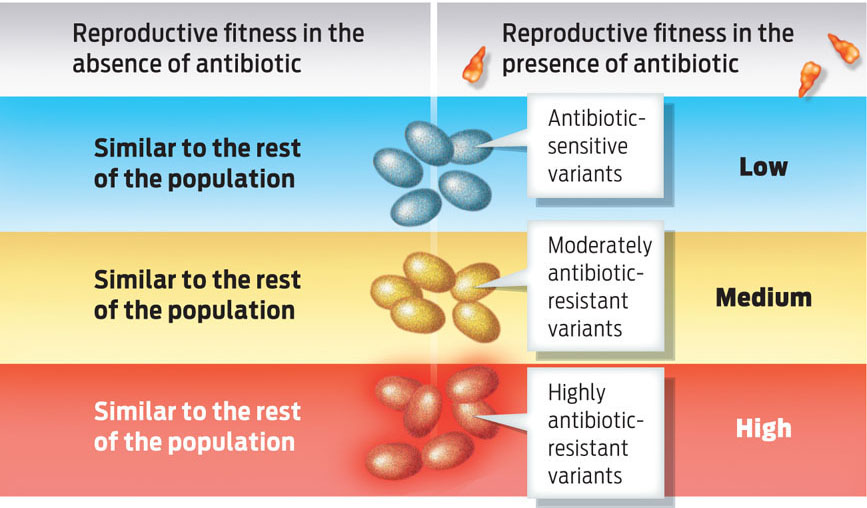AN EVOLVING ENEMY
POPULATION A group of organisms of the same species living together in the same geographic area.
EVOLUTION Change in allele frequencies in a population over time.
While an individual bacterium—or any individual organism—can undergo genetic changes that give it new traits, this doesn’t entirely explain how bacterial populations such as staph develop resistance to drugs. An entire population of organisms with a new trait can arise only when the environment favors that trait—that is, when carrying the specific trait is advantageous to the organisms carrying it. A population is a group of individuals of the same species living together in the same geographic area. Geographic area is relative; it could be an open prairie or a drop of pond water. A population of bacteria can exist anywhere. In the case of staph, populations exist in people’s noses and on other parts of their skin.
FITNESS The relative ability of an organism to survive and reproduce in a particular environment.
When a population’s environment favors some traits over others, the frequencies of the alleles that code for those traits in the population change over time. Take the trait for drug resistance, for example. A genetically diverse population of bacteria will contain some individuals possessing alleles that confer resistance. In an environment free of antibiotics, individual bacteria will have about an equal chance of surviving and reproducing, whether or not they carry a resistance allele; in other words, the ability to resist antibiotics will confer neither an advantage nor a disadvantage, since there are no antibiotics around. But in the presence of an antibiotic, bacteria with an allele for resistance may survive, whereas other bacteria die. The surviving bacteria, which are drug resistant, reproduce and pass their alleles for drug resistance on to future generations. Consequently, the frequency of the resistance trait increases. This is how populations evolve. Evolution is defined as a change in the frequency of alleles in the population over time.
An organism’s ability to survive and reproduce in a particular environment is called its fitness. The higher an organism’s fitness, the more likely that alleles carried by that organism will be passed on to future generations and increase in frequency. In an environment in which antibiotics are abundant, drug-resistant bacteria are more fit than nonresistant bacteria (INFOGRAPHIC 14.5).
The term “fitness” describes the relative ability of an organism to reproduce in a particular environment. Fitness is determined by the interaction between phenotype and environment. Antibiotic-resistant bacteria, for example, have high fitness in the presence of antibiotics.

And in the United States, antibiotic use is widespread: in 2010, antibiotics were prescribed at the rate of 801 prescriptions per 1,000 people. This makes the United States a top consumer of antibiotics on a global scale. The abundance of antibiotics in the environment has created the perfect breeding ground for antibiotic-resistant staph.
In a different environment, however, one in which antibiotics are less common, these same resistant bacteria will not necessarily have an edge over other bacteria. In other words, fitness is always relative to the environment; organisms can be fit in one environment and not in another.